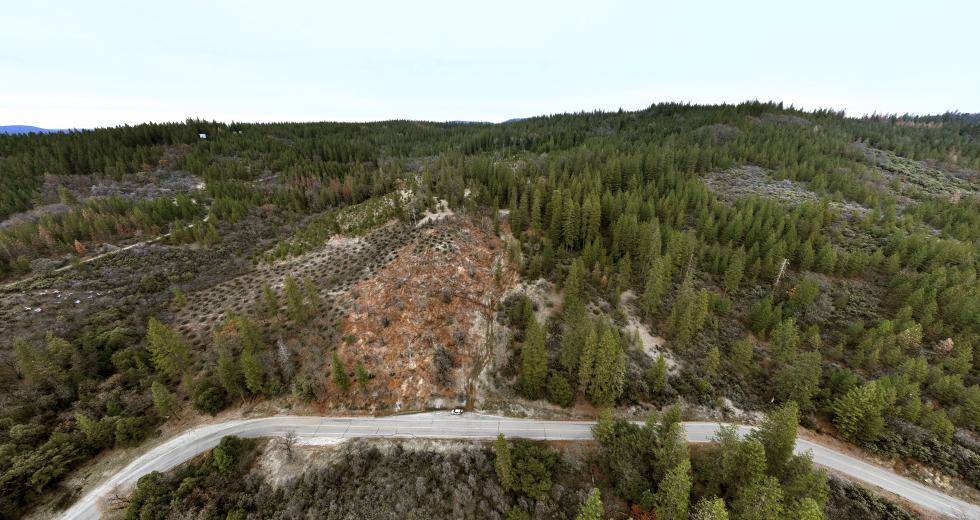The 356,000-acre watershed of the North Yuba River, which straddles Highway 49 from Camptonville in Yuba County to the Sierra Crest, contains one of the largest unburned forests in the Sierra Nevada. That makes it a rare and valuable natural resource, and also creates an enormous risk.
Like many wildlands in the West, thanks largely to a century-plus of fire suppression, this steep, rugged forest is dense and overgrown, mostly with a few species of conifers. Due to drought and climate change, these woods are something of a tinderbox ready to explode.
Willie Whittlesey, a forester by training and head of the Yuba Water Agency, points out that he has witnessed too many catastrophic wildfires in neighboring watersheds over the last four years. He namechecks recent megafires that are probably familiar to people in the Capital Region and beyond.
“Immediately north of the Yuba is the Feather (River), where they had the Camp Fire that burned Paradise in 2018,” Whittlesey says. “In 2020 they had the North Complex, and in 2021 they had the Dixie Fire. South of us, on the American River watershed, we had the Mosquito Fire this year and the Caldor Fire last year. Our watershed’s forests are overstocked with fuel just like those were. That’s why we’re trying to collaborate to restore the forest — before the big fire gets here.”
The collaboration Whittlesey refers to is the North Yuba Forest Partnership, an undertaking that includes the largest land-restoration project in the state of California by far. It is one of 10 immense, landscape-altering projects in the country, and is being funded in part by $25.5 million allocated in the 2021 Bipartisan Infrastructure Investment and Jobs Act.
The North Yuba Forest Partnership’s primary goals are protecting communities in Yuba and Sierra counties from wildfire and protecting the streams that feed the North Yuba River and fill the New Bullards Bar Reservoir. This involves a decades-spanning effort to improve the health of the forest.
The project intends to make all of this work economically sustainable by developing a local economy built on wood and other biomass that is now clogging the forest. The nine agencies and organizations who have signed on to the agreement envision sawmills that can handle small-dimension logs and biomass facilities that turn wood chips into electricity. Their plans include workforce development programs that teach students forestry-related skills, using wildfire fuel to create jobs in one of California’s poorest regions.
JoAnna Lessard, a biologist who runs the Yuba Water Agency’s forest resilience program, explains that all of this is necessary because the natural system that prevented catastrophic megafires for eons needs to be replicated.
“In a resilient forest, when a fire starts we can let it burn itself out,” Lessard says. “That naturally keeps the forest thin, and creates meadows and breaks and the heterogeneity that is the natural state of the forest. Now, there is no way to avoid catastrophic fire without manually doing what nature would’ve done before, and for 100 years hasn’t been allowed to do.”
“In a resilient forest, when a fire starts we can let it burn itself out. That naturally keeps the forest thin, and creates meadows and breaks and the heterogeneity that is the natural state of the forest. Now, there is no way to avoid catastrophic fire without manually doing what nature would’ve done before, and for 100 years hasn’t been allowed to do.”
JoAnna Lessard, Biologist, Yuba Water Agency
In addition to prescribed burns, which land managers often refer to as “putting fire back on the ground,” the North Yuba plan employs what it terms “ecologically based thinning.” Eli Ilano, supervisor of the Tahoe National Forest, which includes 250,000 acres of the North Yuba watershed, says his agency is committed to that practice.
The U.S. Forest Service, which once saw its primary constituencies as the timber industry and its logging towns, is now driven by ecological principles, Ilano says. From Smokey the Bear’s paranoia about fire to the agency’s embrace of destructive practices such as clear-cutting, the USFS helped create a dangerous situation. Now, it’s working hard to take better care of the 193 million acres under its management.
JoAnna Lessard, a biologist who runs the Yuba Water Agency’s
forest resilience program, stands by an area of forest land that
has been restored.
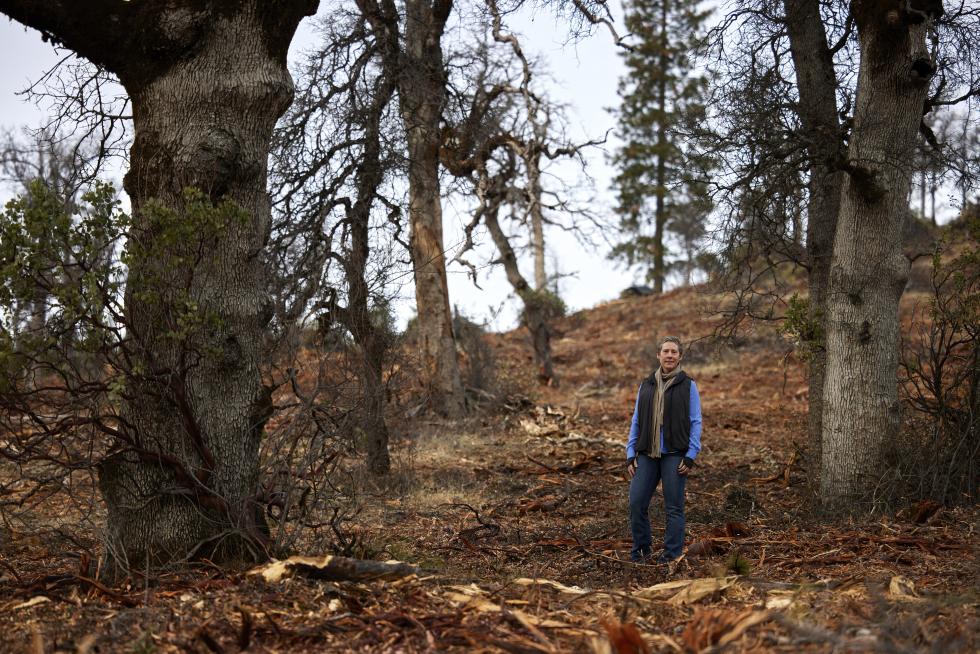
“One of the things that’s changed in the last 20 years is the idea that we need to manage the forest for the health of the forest and the protection of those communities,” Illano says. “Timber is going to be a byproduct of that, but it’s not the driving force.”
While merchantable timber will help pay for the thinning work, the main product of forest-thinning operations presents land managers here and throughout the west with a gnarly problem. Most of the highly flammable trees, bushes and forest-floor duff — the biomass — that needs to come out of the woods is of little value. That’s in part because there is no infrastructure in place to deal with it.
The Yuba Water Agency is helping solve that problem in its watershed by working with four nonprofit members of the North Yuba Forest Partnership and the Camptonville Community Partnership, which has served the area in numerous ways since 1996. After more than a decade of planning, CCP is now poised to build a 3-to-5-megawatt forest-waste biomass plant just up the road from the New Bullards Bar Dam.
In October, Yuba Water helped CCP purchase 100 acres next to a site already approved for that facility. It’s there that the proponents of the North Yuba Forest Partnership envision an industrial center that will revitalize the region and serve as a model for rural communities throughout the west.
Fueling a new economy
Lindsey Nitta, who manages the bioenergy project for the Camptonville Community Partnership, stands on a logging road and gestures toward some terraced land that appears to have been logged fairly recently. She explains that until CCP received the grant from Yuba Water that allowed them to purchase the property, they had leased 11 acres from Sierra Pacific Industries, the nation’s largest private landowner.
Owning this piece of property will allow CCP to lease space to startups and others interested in biomass. If all goes to plan, the Forest Biomass Business Center will be an industrial complex that includes innovators in the nascent biomass field, and a business incubator to help them get up and running. This makes the whole project much more feasible, Nitta says.
“There is a lot more biomass on our land than our own bioenergy facility would ever be able to process,” Nitta says. “So the larger vision is to have a business campus that will allow us to utilize the biomass coming from the (North Yuba) land management and restoration projects, and to attract businesses that can support those projects.”
Sherri Elliott, former national budget director of the U.S. Forest Service, who sits on the board of the Camptonville Community Partnership, says the North Yuba Forest Partnership represents a remarkable convergence of events. “The stars aligned,” she says.
Elliott places the project’s inception in 2010, when Cathy LeBlanc, CCP’s executive director, began talking about bioenergy. LeBlanc recalls attending a presentation about biomass generators put on by the Yuba Watershed Protection and Fire Safe Council, and immediately realizing that there were a couple sites in Camptonville that might work for a smallish project.
“The two suggestions I gave were included in the feasibility study, and we ranked high as potential sites,” LeBlanc says. “But an aggregate company in the Yuba foothills had a plan to build a 12-megawatt site, and that just blew the rest of us out of the water.”
Two years later, the California legislature passed SB 1122, which required power companies including PG&E, to purchase energy from small, community-based biomass plants located near forest communities. Soon afterwards, the California Energy Commission awarded CCP a grant to kick-start its efforts.
Fast forward to 2016, when the 50-year contract between PG&E and Yuba Water, struck when the New Bullards Bar Dam was built following devastating floods in Marysville and Yuba City, came to a close. That gave the water agency the ability to generate significant revenue by selling power to California’s grid, and they used some of that money to support CCP and other elements of the North Yuba plan.
Around 2019, Elliott says, she decided it was time to take advantage of her USFS connections. She and LeBlanc, who’ve been friends for 40-plus years, reached out to the Tahoe National Forest, as well as The Nature Conservancy.
“We started seeing that we needed to hook ourselves to something that has some name recognition,” Elliott recalls. The two women decided that instead of focusing only on bioenergy, they would make their biomass-burning facility an important piece of something bigger.
In addition to Tahoe National Forest, the National Forest Foundation and The Nature Conservancy, the NYFP signatories include Sierra County, the South Yuba River Citizens League, Yuba Water Agency, Campton Community Partnership and the Nevada City Rancheria Nisenan Tribe. And the nonprofit Blue Forest Conservation brings something to the table that could be the key to success for this project and others like it: private capital.
Fighting fire with finance
Of all the innovative strategies being employed by the NYFP, the most promising might be a new financial instrument developed by Blue Forest. Committed to finding ways for mission-driven investors to participate in wildfire mitigation and forest restoration projects, the San Francisco-based nonprofit invented the Forest Resilience Bond.
It’s an unfortunate and well-known fact that working with public land management agencies can create long delays between the completion of a project and payment. And in finance, of course, cash flow matters. The Forest Resilience Bond allows nonprofit organizations to have money in the bank so contractors such as logging companies can be paid quickly.
In 2018, Blue Forest funded a 15,000-acre project in the North Yuba watershed in partnership with Tahoe National Forest. It marked the first time private investment was brought to bear on a public forest restoration effort, and allowed the Forest Service to complete a project in four years that otherwise would have taken 10 years or more. The North Yuba Forest Project is using the Forest Resilience Bond to finance more than $100 million in restoration work.
To hear Eli Ilano, Tahoe National Forest supervisor tell it, the partnership between Tahoe National Forest and Blue Forest Conservation was a matter of stars aligning. A graduate school alumni of UC Berkeley, he met the founders while they were graduate students at Berkeley’s Haas School of Business.
“They were looking for places to pilot this idea and had talked to a couple of different forest supervisors,” Ilano recalls. “And the first time I talked to them, I felt like, ‘You guys are my people.’ I found out one of them happened to be coming through Tahoe on a ski vacation, and I said, ‘Why don’t we meet on the ski lift?’”
The new partners got to work immediately, and over the next several months they decided to pitch the idea to the Yuba Water Agency. Ilano recalls that they carefully prepared a presentation for the agency’s board of directors, including a slideshow detailing a cost benefit analysis that had been prepared with the help of the World Resources Institute and numerous Ph.Ds.
“At the board meeting we were all dressed up in ties, because we thought this was going to be a big pitch,” he says. “When we got there, they had all done their homework, read everything we had prepared in advance. Before we even got to slide five, they were already sold.”
All parties involved believe this innovation in finance could be exactly what’s needed to help save the west from wildfire. Citing a report by Forest Trends and JP Morgan, Blue Forest says there is more than $3 billion in sustainable investment capital undeployed “due to a lack of investment opportunities in the conservation finance space.”
Cathy LeBlanc is pleased to see this movement growing, and to witness the project she’s been working on for more than a decade getting so much love. But, she says, “it’s a double-edged sword.”
“There are billions of dollars that have been put towards forest health,” she says. “But trying to corral the few million we need to complete this project has proven to be difficult. We will complete it — I am 100 percent sure of that. I don’t want to sound like I’m fearless, but in order to do something like this, I think you have to have a certain amount of fearlessness.”
Editor’s note: At press time, Comstock’s received an email announcing Placer County was awarded a $2 million grant through Cal Fire to develop a new biomass facility at the county’s Cabin Creek property near Truckee in north Lake Tahoe. The biomass facility aims to reduce wildfire risks and improve forest management.
–
Stay up to date on business in the Capital Region: Subscribe to the Comstock’s newsletter today.
Recommended For You

The Might of Mycelium
How fungi is changing food, agriculture and the environment in the Capital Region
Companies and researchers are finding ways to use mycelium,
the vegetative body of fungi, to solve problems including
plastic waste, greenhouse gas emissions, antibiotic residue in
water supplies and more.
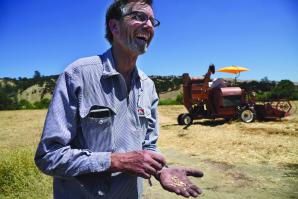
Status Check: Capay Mills Joins SMBX Marketplace
The Yolo County artisan flour business receives more than $115,000 in investment
Sourdough is having a moment, and so is artisan flour business Capay Mills, thanks to an influx of small business bonds.
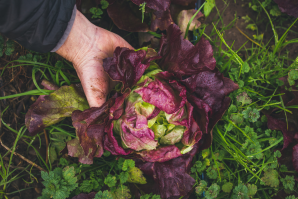
Recruiting California’s Next Generation of Farmers
Organizations in the Capital Region provide aspiring farmers with the business tools they need to succeed
Local food may be the future, but many Northern
California farmers are struggling
or retiring. To brighten the future of farming,
nonprofits are cultivating a new crop of agrarian
dreamers with comprehensive farming programs.

DMV for Cows?
iPads to beef up California’s cattle inspection process
If you’re one of those motorists who describe the whole DMV experience as slow, torturous and/or dystopian, consider the cow.
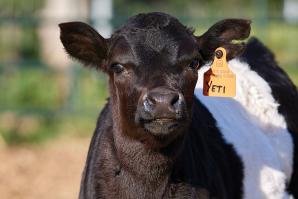
Greener Pastures
Long Dream Farm aims to prove that dairy production can be both ethical and economically viable
Andrew and Krista Abrahams want to rethink the assumptions of traditional dairy production.

Startup of the Month: ViVita Technologies
Medical device startup pumps innovation into replacement heart valves
A healthy human body is a fortress with guards at the ready to seize intruders. When under attack, these guards (antibodies) secrete chemicals that recruit and grow immune cells. The cells then seek and destroy the intruders (antigens) to protect the fortress.
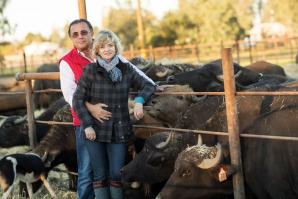
How Asian Water Buffaloes Got to Sacramento County
One of the only water buffalo dairies in the United States is
Morsey’s Farm in Wilton, which makes Italian-style cheese and
gelato.



